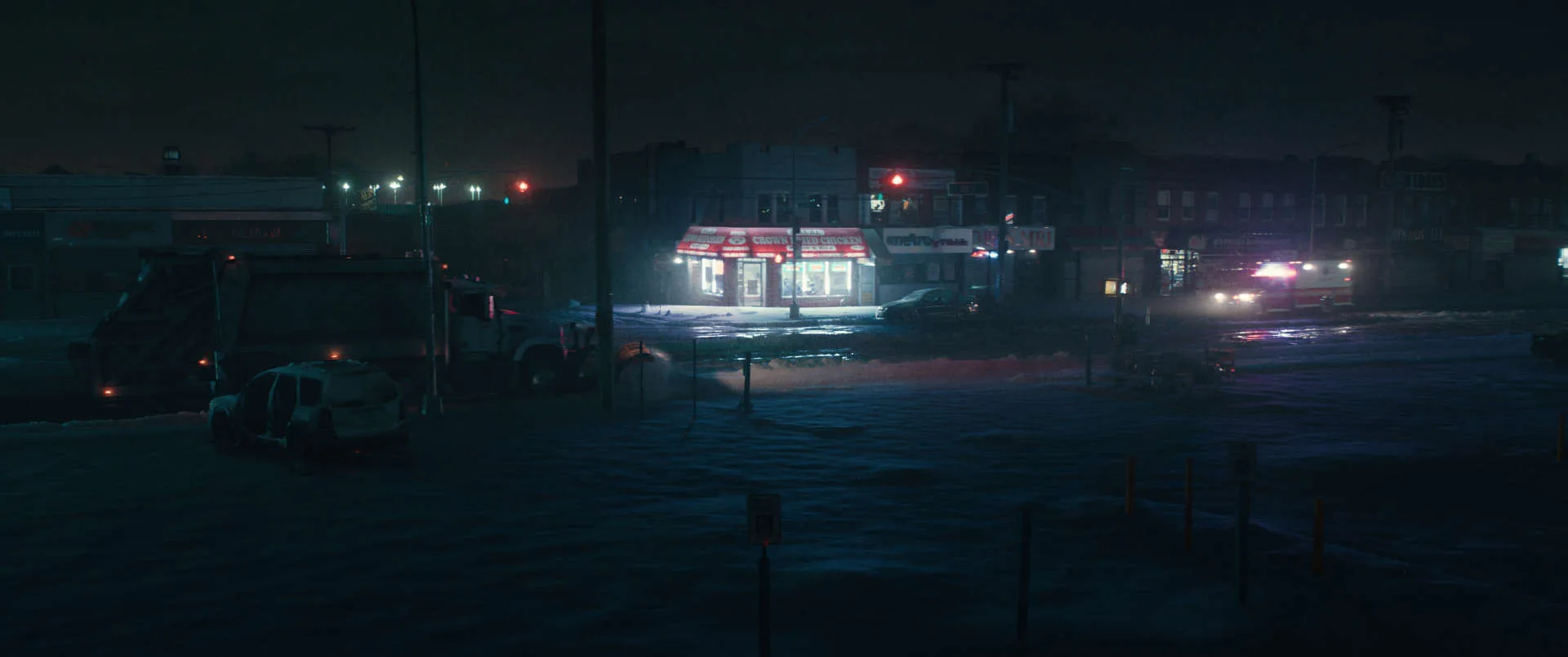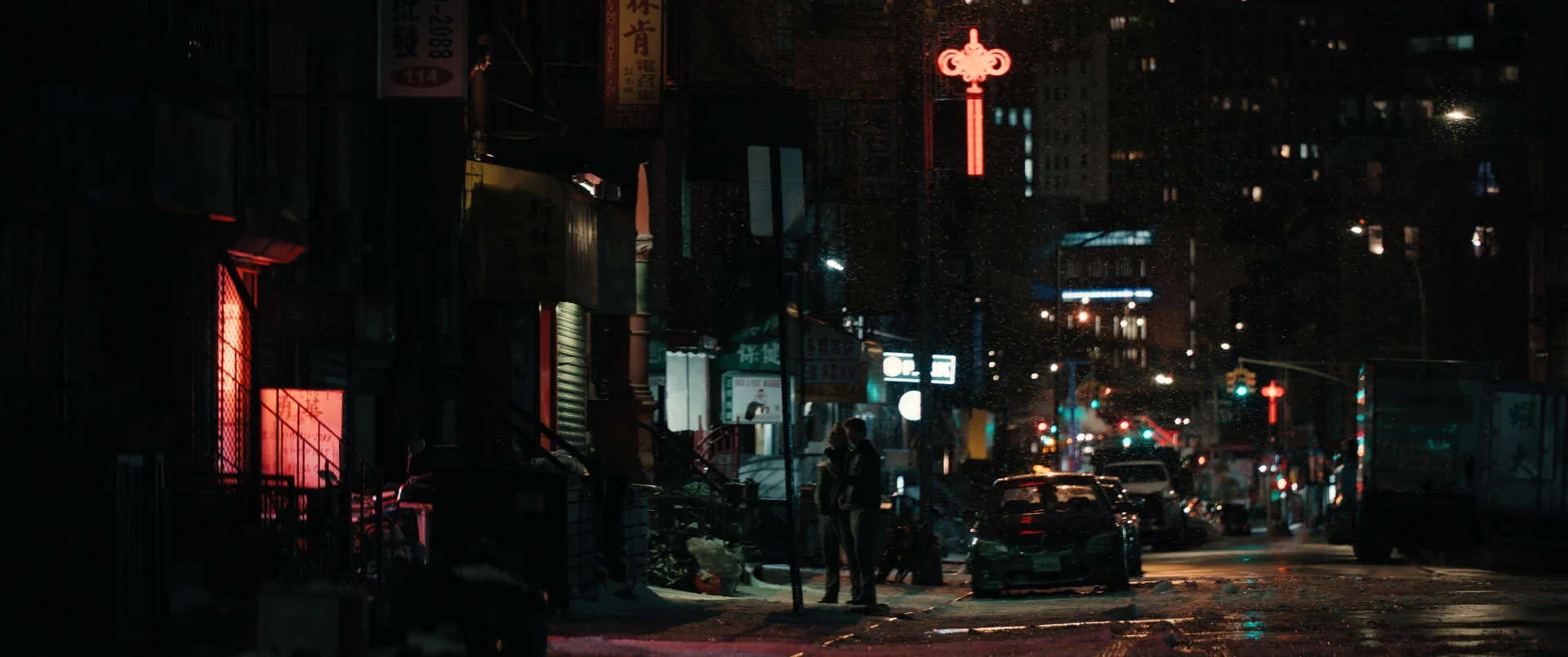In 2023, Huw Evans shared insights into beloFX‘s visual effects work on Fast X. He later contributed to The Wheel of Time. Today, he discusses the subtle visual effects behind Wolfs.
How did you and beloFX get involved on this show?
I had my first meeting with Janek Sirrs (Production VFX Supervisor) and Mitchell Ferm (Production VFX Producer) in April 2023 while they were filming in Los Angeles. It was my first time working with them, though Janek had previously worked with some members of the beloFX founding team, so he was already familiar with who we were and what we could deliver. The script was fantastic, and the visual effects work looked compelling, so we were excited to join the project.
How was the collaboration with Director Jon Watts and VFX Supervisor Janek Sirrs?
It was my first time working with both Jon and Janek, but I was already aware of their recent work on the latest Spider-Man movies (of which I’m a huuuge fan!) so I was excited to meet them both. We worked closely with Janek throughout the project, with regular calls to discuss the vision and approach. He was a great collaborator, providing us with clear direction and references but also giving us the freedom to bring our own creative solutions to the table and explore alternative ideas where we thought we could help. Personally, I love this kind of collaboration in VFX — it’s an industry driven by artists, after all! Embracing that spark of creativity is often where the real magic begins to emerge. We truly appreciated the collaborative spirit that both Janek and Jon brought to the process.


How did you organize the work with your VFX Producer?
This was my second show working with the wonderful Jan Meade, our beloFX VFX Producer. She’s incredibly level-headed and exceptional at her job, making it an absolute pleasure to work alongside her on this project. The work was distributed across several of our sites, with the London hub leading the charge with the generalist type work while most of the FX-related work was handled by our Canadian office. Balancing the skill-sets of our available artists with delivering the best value for our clients is always a priority – alongside making some amazing visuals obviously!
What are the sequences made by beloFX?
We were responsible for the majority of the VFX work in the second half of the movie, focusing primarily on digital snow and environment work, among other bits and pieces. We worked on a large amount of the film’s wide establishing shots, and also a large number of the car interior shots. There were also exterior shots outside June’s apartment, around Club Ice, outside the warehouse and we worked on the shoot-out under the underpass too, among other sections.


Can you explain the role of invisible visual effects in Wolfs and why they’re essential for the story?
The action unfolds over one snowy night in New York and, as with any production, nobody can control the weather. So, our work was to create a photorealistic snowfall that starts out light and subtle, but progressively builds as the story continues.
Our goal from the start was to keep the work invisible. It wasn’t about spectacle but about achieving realism and subtlety. Ideally, a production would capture this in-camera using practical effects like fake snow. However, in this case, shooting permits had specific limitations — for instance, crushed ice could only be placed on pavements, not roads. Add to that the unpredictability of wind, which can make SFX foam towers unreliable, and the need for VFX support became clear to achieve the desired look.
In the end, nearly every shot featuring snow was either entirely created with VFX or at least augmented with it. So there was quite the challenge in ensuring that it looked convincing and consistent throughout the entire film.


Could you walk us through the process of adding snow effects in a realistic way that blends seamlessly with live-action shots?
Our process would generally begin by looking at the practical SFX snowfall captured in-camera, if any was used for a given shot. In some cases, the practical effects worked well — the behaviour looked natural and only needed to be augmented or thickened to achieve the desired density. These cases provided an excellent reference for the FX team to match the behaviour of our digital snow which was really helpful.
In other cases, the practical flakes might prove too distracting or behave unpredictably, maybe they’d catch too much wind due to being made of lighter foam for example. For these scenarios, our process would be to remove the practical snow — either procedurally if it was particularly heavy or manually if it was lighter. From there, we’d create a full digital replacement to achieve the desired behaviour.
In some instances, there was no snow visible in the plate photography at all, so we’d go fully digital, ensuring we’re matching the surrounding shots in the sequence.
For the ground-based snow, we’d take the lidar data of the environment where the shot was set, and use it to procedurally generate a blanket of snow that gathered and reacted to the underlying geometry. Naturally, this required some manual clean-up and adjustments, but it provided an excellent starting point and gave us full control over the snow levels for different moments throughout the movie’s timeline.


In terms of environmental effects, were there any particular elements of New York’s winter ambiance you found challenging to replicate?
There were a few key elements we had to work especially hard on to get just right. In the film’s earlier sequences, while the snow was light, we needed to digitally ‘wet down’ the streets. This involved adding digital puddles reflecting the multicoloured shop lights and passing cars, and even creating a wet sheen on some of the surrounding buildings to capture that “snow just starting to settle” feel.
We also took great care to add small details and subtleties, like snow settling on the branches of a tree. This required a full paint out and removal of the tree from the plate, then matching back to the photography with a fully CG tree covered in a dusting of snow which worked great with the moving camera in the shot. Things like that took a bit of time to get just right.
Then, as the snow grew heavier, the roads needed to be populated with a mix of compressed ice, softer slush that reacted to car movements, and a lighter top layer of snow dusting — all working together to give the right feel. We also had to keep track of the hero car, ensuring it accumulated snow as the story progressed. This involved a combination of static geometry pieces and animated, FX-driven snow all working together with the practical moving car.
Some of the more subtle environmental effects included the unique depth hazing that occurs when light layers of snow stacks up, creating an interesting mist-type look. We played with this a lot, especially in our wider establishing shots, which helped sell the overall ambiance.


How do you measure success in invisible effects when the goal is for audiences not to notice them?
I think that’s a rather interesting question actually. I guess the answer is exactly that — when audiences don’t notice our work! We all love creating the big VFX spectacles, something unimaginable and fantastical has its own joys and rewards, but there’s always something super challenging and hugely rewarding about the invisible effects and knowing that people watching it wouldn’t suspect a thing. I always enjoy watching VFX breakdowns and seeing the ‘before and afters’, it’s like looking behind the curtain and seeing a magician reveal their secrets, as dramatic (and cheesy) as that might sound!


Were there any real-world references that you relied on heavily to ensure the authenticity of the New York winter look?
It’s always, always, always beneficial to draw from references, and in this case, Jon had a few key photographs that captured the look and feel he wanted to create, so we continually referred back to those images. We also had specific falling snow references that Janek sent over, which were invaluable in helping us figure out the right speed and density needed for this movie. As with any VFX work, working from real-world references always leads to better results. Whether we’re creating something fantastical or something grounded in reality, we can always find little clues within references that help guide the way forward.
Looking back, is there a specific invisible VFX shot or environment in Wolfs that you’re particularly proud of?
One of my favourite shots is a wide view of the street outside the apartment, where we added a complete road wet-down and integrated two differently lit practical photography plates to create the final look. We also added falling FX snow, illuminated by streetlamps. This single shot really contained a lot of our working methodology, and it ended up looking extremely similar to some of the reference photography Jon had guided us toward so it felt great to get that just right. Plus, it’s the kind of shot where people wouldn’t necessarily know anything had been done to it, and those shots are always quite fun!


Which sequence or shot was the most challenging?
I’d actually say some of our car windscreen wiper shots. Perhaps not the most technically challenging in terms of what we were doing (or the most exciting ones to shout about!), but adding the windscreen wipers to the hero car and ensuring the smear on the glass looked correct, along with the way the light dusting of snow settled on the glass and then got wiped off, was a surprising challenge! Hopefully it works as one of those totally natural, invisible effects mentioned earlier.
Is there something specific that gives you some really short nights?
As is usually the case, it was probably just the race to the finish line! Even when you think you’re ahead on certain aspects of the work, it’s managing those curveballs and new shots that come in at the last minute and rolling with them. I guess that’s part of what keeps it exciting working in VFX, right? Maybe? Who needs sleep anyway!


How long have you worked on this show?
I started on the show back in April 2023 and we delivered in April 2024 so pretty much a year in total.
What’s the VFX shots count?
We delivered just under 300 shots – 298 to be exact!
What is your next project?
I’m currently working on an unannounced TV series for Prime Video… stay tuned!
A big thanks for your time.
WANT TO KNOW MORE?
beloFX: Dedicated page about Wolfs on beloFX website.
© Vincent Frei – The Art of VFX – 2024






